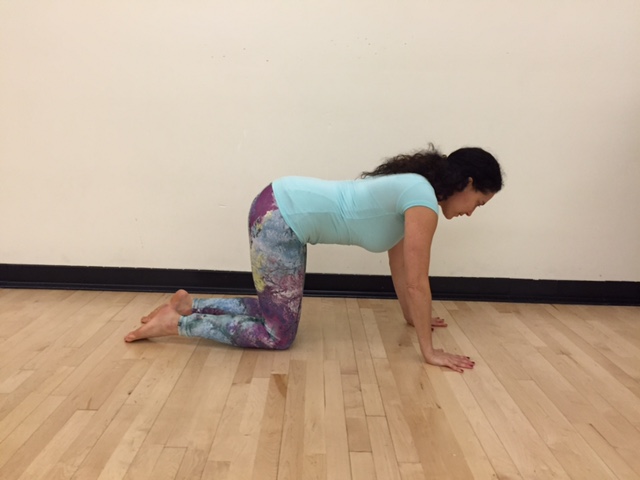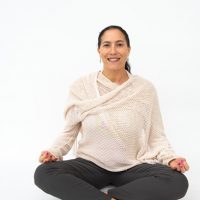When I was in high school in New York I had a neck injury that caused great discomfort.
When suggested to do yoga, I tried it from a Lilias Folan VHS tape, since this was before the days of seeing yoga studios all over. Within one 30 minute video session my months of prior neck pain as well as other tensions and anxieties completely vanished.
I was hooked right away and continued to practice daily 30 minutes after my high school classes.
Although my neck pain had vanished, I felt a deep peace after each practice session so when I was in college I continued to practice daily in my dorm room, memorizing the video sequence I practiced in high school and then using the Sivananda Companion to Yoga book, where I learned my first 1.5 hour sequence. Eventually, because my father was practicing yoga already, by the time I was in college I knew where to go to attend my first class: the Sivananda Yoga Center in NYC. This included the full aspects of hatha yoga, which started each class with mantras, chanting and breathing techniques to create energy and balance the nervous system.
Yoga ultimately gave me so much more than relief of neck tension, which was my first and only intent to start the practice. Since then it has given me tools to bring more balance, flexibility, strength and peace to my body, mind and emotions and gives me a safe space to focus inside of myself, regardless of what is occurring in my external world. Because of these immense benefits I continued on in my second year of college to live in an ashram for a month and learn to teach yoga, which I know happily share with others so that they too can improve the quality of their lives and health (in body and mind).
In many large US cities you see so many people doing yoga now and it is even all over the news and media. India just had their first International Day of Yoga June 21, 2015. I happened to be visiting their that day and got to practice in the motherland of yoga, where nearby they gathered over 38,000 yogis in Delhi to practice. “The Prime Minister of India when presenting the idea of International Yoga Day to the United Nations said that “Yoga should not be just an exercise for us, but it should be a means to get connected with the world and with nature,” and also said that yoga is “India’s gift.” And by December, over 177 countries were involved in this day, including the USA, Iran, France and so many more. I agree completely, yoga is a true gift India brought to this world.
So what is Yoga anyway? Yoga or “union” is an ancient science to help us reach a greater connection with ourselves and the world around us. Yoga includes postures (asanas), breathing exercises (pranayama), chanting, relaxation, meditation, nonviolent actions and diet (vegetarian) and healthy, balanced eating and living. Even trying small steps towards greater health and balance in each of these areas can impact your day and life in large ways. Everyone can benefit from yoga as yoga can be modified to suit your needs. The benefits are numerous ranging from pain relief to peace of mind.
A simple way to think of it is that yoga can be summarized as a full lifestyle including five main points. Swami Vishnudevananda condensed the essence of the yoga teachings into five principles for physical and mental health as well as spiritual growth.
Proper Exercises: asana
Proper Breathing: pranayama
Proper Relaxation: savasana
Proper Diet: vegetarian
Positive Thinking and Meditation (dhyana)
A yoga class or practice class can help us to develop balance, well being and peace of mind. It can teach us simple stretches and yoga postures for health, breathing exercises for mental calm, and relaxation techniques to enhance your well-being. You can also learn how to increase flexibility, ease neck, shoulder and back tension and help your balance and concentration. You can find a teacher that offers modifications if you are pregnant, injured or have any health conditions that you aren’t sure how to modify for.
Here are 10 simple points to keep in mind as we practice:
1. In yoga class or on your own, only do the postures or exercises that are comfortable.
2. There should be no pain in the joints or body during the practice.
3. Modify postures or rest as needed.
4. If you have a pre existing injury that is aggravated by a certain movement or exercise please notify the yoga instructor right away.
5. Check with your doctor for any concerns from prior conditions or injuries if you are not sure what you can and can not do.
6. Yoga is not competitive. Go at your own pace.
7. We are all unique- do what is comfortable for your body in each practice.
8. “No pain, no pain.” We do yoga to ease pain in the body, not to create more. Be gentle even if you want a challenge.
9. Ask the instructor for modifications if pregnant, injured, ill or needing a different way to do a pose than is suggested.
10. Enjoy the practice! This is not about right or wrong, winning or losing but to feel better in the body and gain more peace in the mind.
Following the simple concepts above, you can also try a simple two minute yoga practice at home. The benefits are many even from this few minute yoga sequence, including gaining flexibility in the back, hips and legs, improving posture, releasing tension in the shoulders and back as well as increasing circulation and energy in the entire body. For the mind, it is beneficial to increase concentration and peace of mind, by focusing on the breath in the postures.
Here’s my two minute home yoga practice. Check out the video or read the steps below!
*Please check with your doctor for any injuries or health concerns.

1. Table Pose: Start on all fours with your hands under the shoulders and the knees under the hips. Cushion your knees if needed with a blanket or yoga mat.
This posture brings awareness to our back and balance. If you stretch the fingers here as well it is a useful break for the hands from being at a computer all day.

2. Cow Pose (Bitilasana in Sanskrit): Inhale as you lift the head and tailbone, allowing the heart to melt between the shoulder blades and relaxing the navel center towards the earth
This posture brings mobility to the spine and can improve posture, while allowing a sense of opening to the front chest and lungs.

3. Cat Pose (Marjaiasana in Sanskrit): Exhale as you round the back, relaxing the neck. Keep the fingers stretched out on the floor evenly. This posture releases back and shoulder tensions and is a great way to release your neck and back after a long day at your desk. You can hold for 1-5 slow, deep breaths.

4. Downward Facing Dog (Adho Mukha Svanasana in Sanskrit) with the knees bent: as you exhale turn the toes under and lift the hips, creating an upside down triangle shape (like a dog stretching).
This posture stretches the legs and back and tones the arms.

5. Downward Facing Dog
Repeat the steps above, allowing the knees to bend only if the hamstrings need a more gentle variation. Otherwise gently reach the heels back and down as you extend the spine and hips. Spread the fingers wide. Hold 1-5 slow, deep breaths.
This posture stretches the body and allows a sense of expansion, opening and ease to the breath.
Rest in child’s pose: sit on the heels and rest the forehead on the floor in front of you. Child’s pose restores energy and eases the lower back and hips. Slowly roll the spine up and enjoy the benefits of a two minute yoga practice.
“Serve. Love. Give. Purify. Meditate. Realize.” ~ Swami Vishnu Devananda.
Relephant:
A Beginner’s Guide to 25 Awesome Yoga Asanas.
Author: Stacie Dooreck
Editor: Renée Picard
Images: FtMeade/flickr / Images & video in article: Author’s Own












Read 8 comments and reply